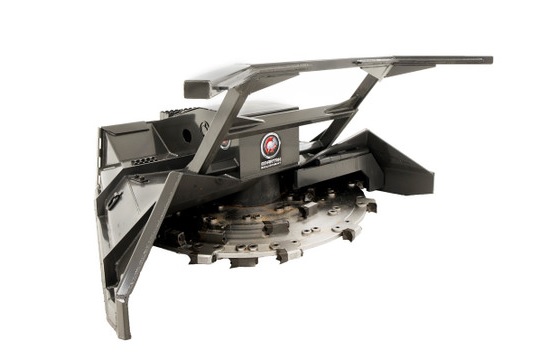Sustainable Site Preparation: Eco-Friendly Practices for Construction Projects
Posted by Lee Padgett on 27th Mar 2024
Construction projects are vital for development, but they can also have a significant environmental impact. Land clearing, a crucial first step, often involves removing trees and vegetation, leading to soil erosion, habitat loss, and disruption of natural ecosystems.
However, with a shift towards sustainable practices, construction companies are increasingly adopting eco-friendly approaches to land clearing and site preparation.
This article explores various environmentally conscious methods and how skid steer attachments, like the innovative skid steer mulcher, can play a key role in achieving a greener construction process.
Minimizing Disruption: Selective Clearing and Preservation
The first step towards sustainable site preparation is minimizing the area of land disturbed. Instead of clearing entire plots, project plans should prioritize selective clearing, focusing only on the areas absolutely necessary for construction.
Existing mature trees and healthy vegetation can be preserved, maintaining natural habitats and reducing soil erosion. This selective approach not only benefits the environment but can also enhance the aesthetics of the final project.
Preserving the Soil: Erosion Control Techniques
Healthy soil is paramount for a thriving ecosystem. Construction activities can easily disrupt the delicate balance of the topsoil, leading to erosion and sedimentation in nearby waterways.
Sustainable site preparation practices prioritize implementing effective erosion control measures. Techniques like silt fences, straw bales, and biodegradable erosion control blankets can be used to trap sediment and prevent it from washing away.
Recycling and Repurposing: Giving New Life to Existing Materials
Construction projects often generate a significant amount of waste. Sustainable practices emphasize recycling and repurposing existing materials whenever possible.
For example, salvaged trees from the clearing process can be chipped and used as mulch for landscaping or turned into lumber for future projects.
Concrete and asphalt from demolished structures can potentially be crushed and reused as base material for roads or pathways.
By minimizing waste generation and promoting resourcefulness, construction companies can significantly reduce their environmental footprint.
The Bobcat Mulcher: A Sustainable Land Clearing Solution
When selective clearing isn't possible and some vegetation removal is necessary, the Bobcat mulcher attachment emerges as a game-changer for sustainable land clearing.

Unlike traditional methods like bulldozing or burning, which remove entire trees and leave behind unusable debris, skid steer mulchers grind vegetation into a fine mulch. This mulch can then be left on-site to decompose naturally, enriching the soil and promoting healthy plant growth.
The Bobcat mulcher's efficiency also minimizes the time spent on clearing, reducing fuel consumption and overall environmental impact.
Here's a closer look at the advantages of using a Bobcat mulcher for sustainable land clearing:
- Reduced Soil Compaction: Unlike heavy machinery used in traditional clearing methods, the Bobcat mulcher exerts minimal pressure on the soil, minimizing compaction and promoting healthy root growth for remaining vegetation.
- Habitat Enhancement: The mulch created by the Bobcat mulcher acts as a natural fertilizer, promoting the growth of new plant life and creating a habitat for beneficial insects and microorganisms.
- Dust Suppression: The fine mulch layer left behind by the Bobcat mulcher helps suppress dust generation, a common problem during construction activities.
Sustainable Practices with Other Skid Steer Attachments
The Bobcat mulcher is a powerful tool for sustainable land clearing, but it's not the only skid steer attachment that can contribute to eco-friendly construction practices.
Here are some other skid steer attachments that can be used sustainably, along with tips for maximizing their environmental benefits:
- Brush cutters: Similar to mulchers, brush cutters can be used for targeted vegetation removal, leaving behind valuable mulch material for soil health. When clearing brush, prioritize preserving mature trees and native plants whenever possible.
- Tree Shears: For selective tree removal, tree shears offer a clean and efficient solution. Harvested trees can be turned into lumber for future projects, reducing reliance on virgin wood sources. Consider partnering with local sawmills or woodworkers to utilize salvaged timber.
- Grapple Buckets: These versatile attachments can be used to move cleared materials like rocks, logs, and brush piles with minimal soil disturbance. By carefully sorting and relocating materials, you can minimize the need for off-site disposal and potentially repurpose some items within the project.
- Sweeper Attachments: During construction, dust generation can be a major environmental concern. Skid steer sweeper attachments can be used to control dust effectively, promoting cleaner air and improved working conditions. Opt for natural dust suppressants like water or enzyme-based solutions for a truly eco-friendly approach.
Building a Sustainable Future, One Project at a Time
Sustainable site preparation is no longer a luxury; it's an essential practice for responsible construction companies.
By employing selective clearing techniques, implementing erosion control measures, prioritizing recycling, and utilizing innovative tools like the Bobcat mulcher, construction projects can minimize their environmental impact and contribute to a greener future.
At Spartan Equipment, we offer a wide range of construction equipment and attachments, including the Bobcat mulcher, to help you build a sustainable future, one project at a time. Browse through our selection of skid steer attachments today to explore how we can help you achieve your environmental goals alongside your construction objectives.


